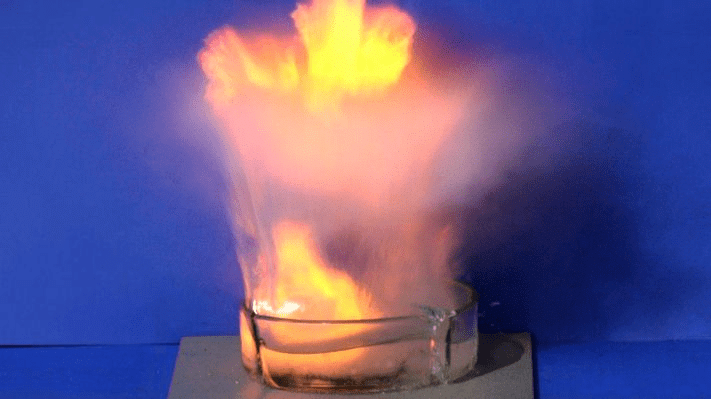Class 8 Science Question Answers - Materials : Metals and Non-metals (Old Syllabus)
Q1: Explain the physical and chemical properties of metals and non-metals.
Ans:
Chemical properties of metals:
- Reaction with oxygen:-
Metals react with oxygen to form metallic oxides. These are basic oxides because they react with water to form bases.
Eg: Magnesium burns in the air to form magnesium oxide.
2 Mg + O2 → 2 MgO - Reaction with water:-
Metals react with water to form metal hydroxides and hydrogen.
Eg: Sodium reacts with water to form sodium hydroxide and hydrogen.
2Na + 2H2O → 2NaOH + H2 Reaction of Sodium with WaterE.g: Magnesium reacts with water to form magnesium hydroxide and hydrogen.
Reaction of Sodium with WaterE.g: Magnesium reacts with water to form magnesium hydroxide and hydrogen.
Mg + H2O → Mg(OH)2+ H2 - Reaction with acids:-
Metals react with acids to form metallic salts and hydrogen.
Eg: Zinc reacts with dilute hydrochloric acid to form zinc chloride and hydrogen.
Zn + 2HCl → ZnCl2+ H2 - Metals replace metals:-
A more reactive metal replaces a less reactive metal from its salt solution.
Eg: Magnesium replaces copper from copper sulphate solution to form magnesium sulphate and copper.
Mg + CuSO4 → MgSO4+ Cu
Zinc replaces copper from copper sulphate solution to zinc sulphate and copper.
Zn + CuSO4 → ZnSO4 + Cu
Chemical properties of non-metals:
1. Reaction with oxygen:
Non-metals react with oxygen to form non-metallic oxides. These oxides are acidic because they react with water to form acids.
Eg: Sulphur burns in air to form sulphur dioxide. Sulphur dioxide reacts with water to form sulphurous acid.
S + O2 → SO2
SO2+ H2O → H2SO3
2. Reaction with water:
Non-metals do not react with water.
3. Reaction with acids:
Most non-metals do not react with acids.
Some non-metals like sulphur react with concentrated nitric acid to form sulphur dioxide, nitrogen dioxide and water.
S + 4HNO3→ SO2 + 4NO2+ 2H2O
Physical properties of metals:
- Metals are solid except mercury.
- Metals are hard.
- Metals are malleable that is can be beaten into thin sheets.
- Metals are ductile that is can be drawn into wires.
- Metals that produce ringing sounds are called sonorous.
- Metals are lustrous.
- Metals are good conductors of heat and electricity.
Physical properties of non-metals:
- Non-metals are solid, liquid or gas.
- Non-metals, which are solid, are brittle (diamond is the hardest).
- Non-metals are soft and dull in appearance.
- Non-metals are not malleable and break down into powdery mass on tapping with a hammer.
- They are not sonorous.
- They are poor conductors of heat and electricity..
Q2: Explain differences between metal and non-metal based on their properties like hardness, malleability, ductility, appearance, and heat conduction.
Ans:
| Metals | Non - metals |
|
|
Q3: Give a reason why copper cannot displace zinc from its salt solution and why sodium and potassium are stored in kerosene.
Ans: Copper cannot displace zinc from its salt solution because zinc is more reactive than copper. A more reactive metal can replace a less reactive metal, but a less reactive one cannot replace a more reactive metal. Therefore, copper cannot displace zinc from its salt solution.
Sodium and potassium are stored in kerosene because Sodium metal is very reactive. It reacts vigorously with oxygen and water. A lot of heat is generated in the reaction. It is, therefore, stored in kerosene.
Q4: Write a word equation of the following reactions:
- Sulphur burning in the air
- Sulphur reacts with concentrated acid
- Iron nail placed in a copper sulphate solution
Ans:
- Sulphur burning in the air: Sulphur burns in the air to form sulphur dioxide. Sulphur dioxide reacts with water to form sulphurous acid.
S + O2→ SO2
SO2+ H2O→ H2SO3 - Sulphur reacts with concentrated acid to form sulphur dioxide, nitrogen dioxide and water.
S + 4HNO3 → SO2+ 4NO2+ 2H2O - When an iron nail is placed in copper sulphate solution, iron replaces copper from copper sulphate, thus, nails become copper plated, and the blue color of the copper sulphate solution disappears and solution turns from blue to light yellowish. The following reaction occurs:
Copper sulphate (CuSO4) + Iron nail (Fe) → Iron sulphate (FeSO4) + Copper (Cu)
Q5: What happens when dilute sulphuric acid is poured on a copper plate?
Ans: When dilute sulphuric acid is poured into a copper plate then, copper undergoes a reaction with acid to form metal salts CuSO4, a blue crystalline solid and hydrogen gas:
Cu (Copper) + H2SO4 (Sulphuric Acid) → CuSO4(Copper sulphate) + H2 (Hydrogen gas)
|
137 videos|271 docs|60 tests
|
FAQs on Class 8 Science Question Answers - Materials : Metals and Non-metals (Old Syllabus)
| 1. What are metals and non-metals? |  |
| 2. What are some common examples of metals and non-metals? |  |
| 3. How do metals and non-metals react with oxygen? |  |
| 4. What are the physical properties of metals and non-metals? |  |
| 5. How do metals and non-metals react with acids? |  |
















